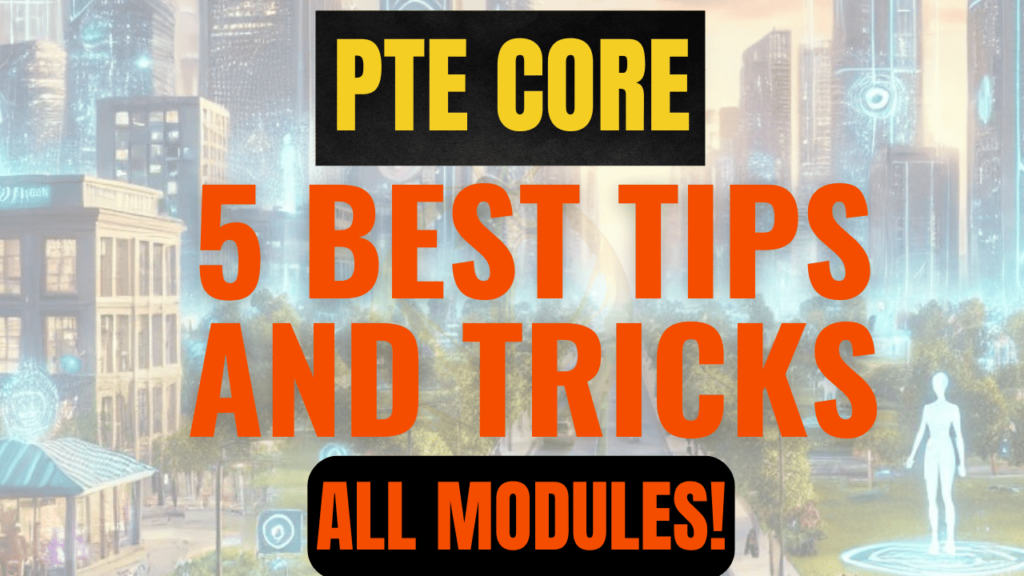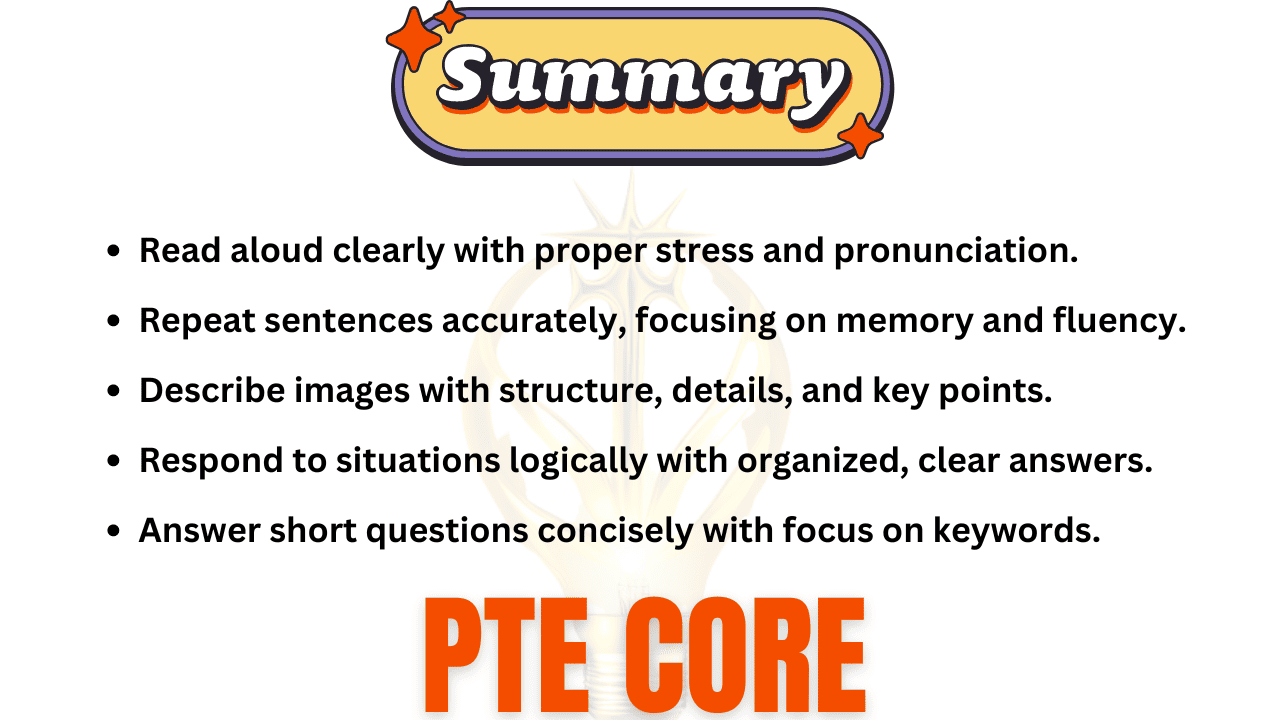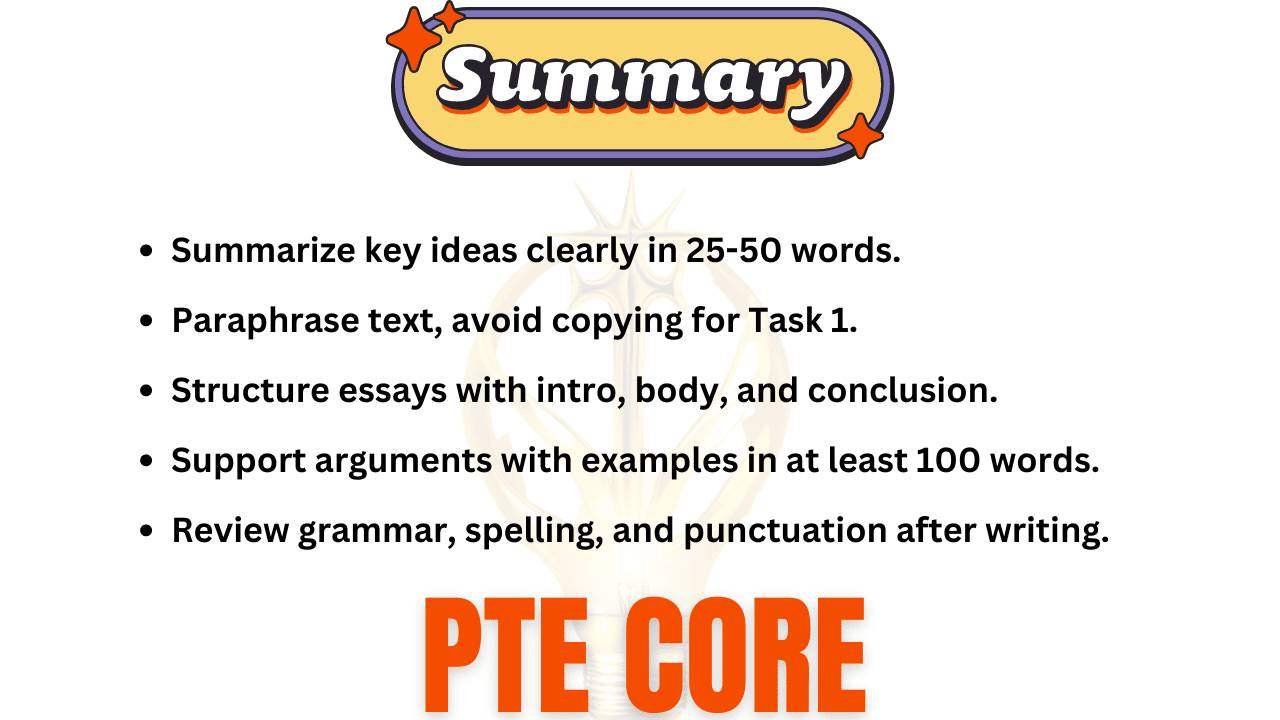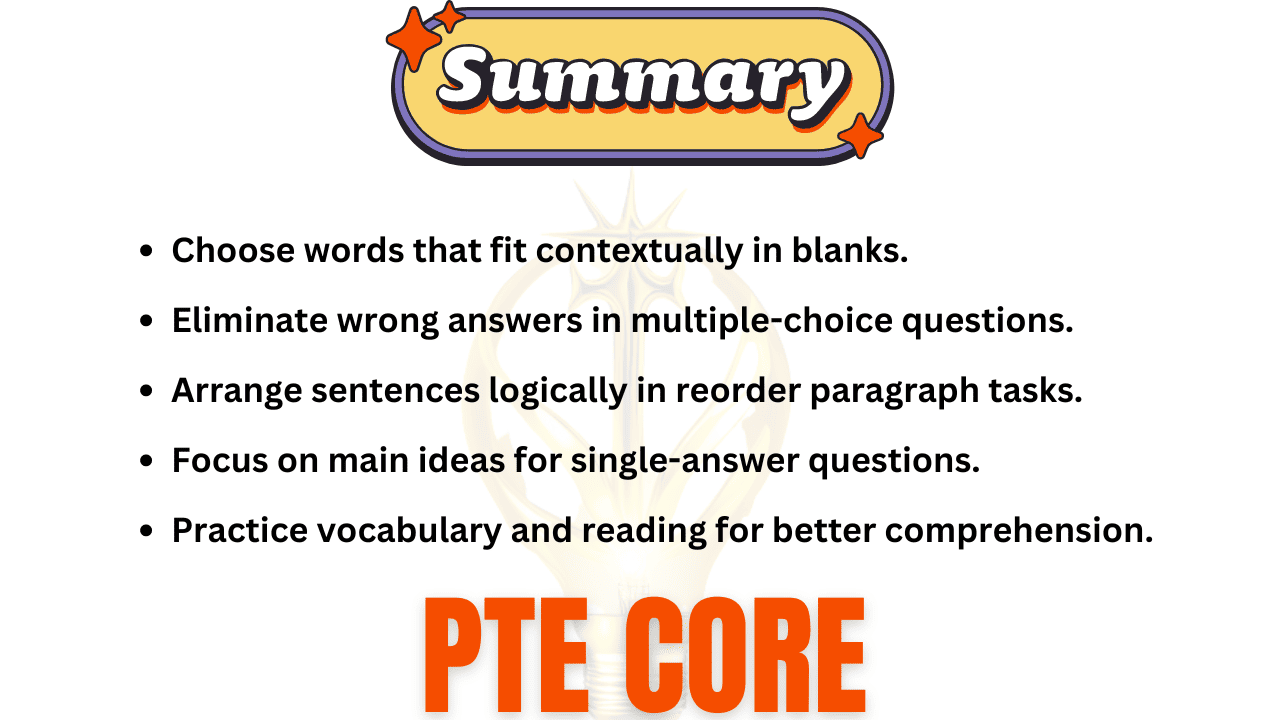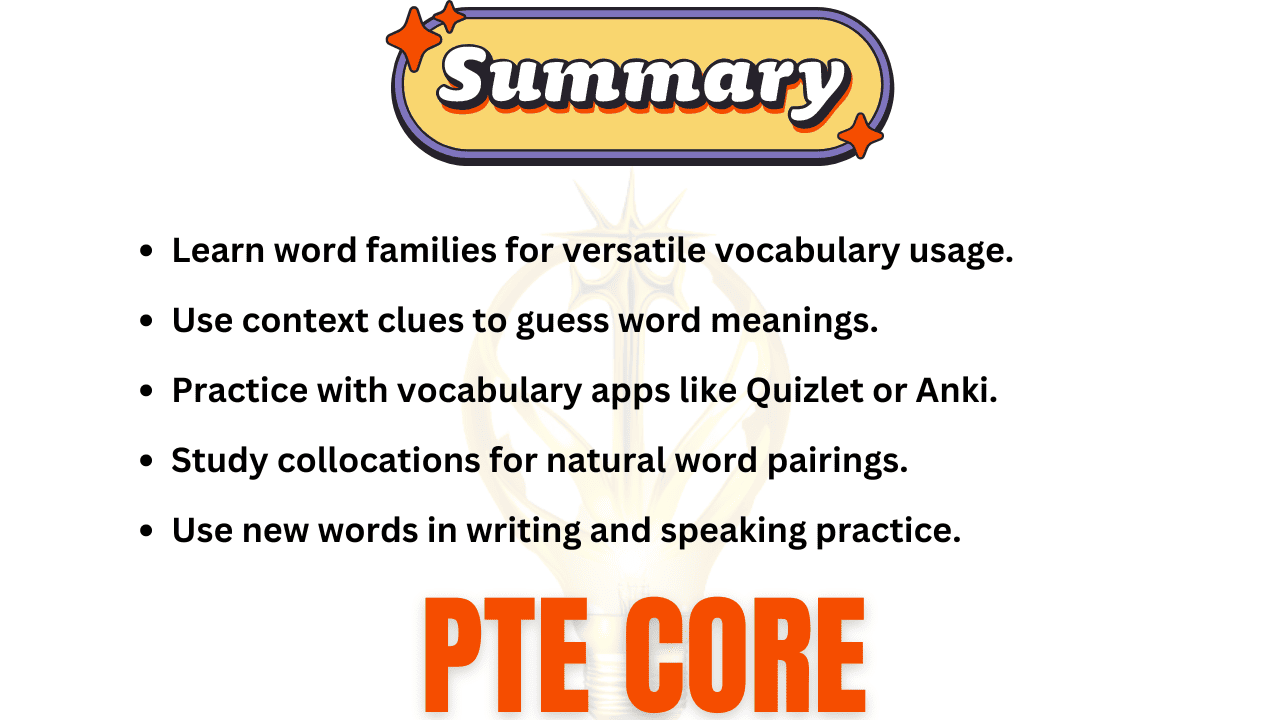In this blog, we’ll explore the 5 Best PTE Core Tips and Tricks to help you ace the exam and approach each section with confidence. Let’s cover all modules!
How to Pass the PTE Core Speaking Test for CLB: Tips and Sample Answers
If you’re preparing for the PTE Core Speaking Test and aiming for a high CLB (Canadian Language Benchmark) score, it’s essential to understand the tasks you’ll face and how to approach them effectively. The PTE Core speaking section includes the following tasks:
- Read Aloud
- Repeat Sentence
- Describe Image
- Respond to a Situation
- Answer Short Questions
This blog will break down each task with strategies and sample responses, focusing on what you need to do to achieve a high CLB score.
1. Read Aloud
In this task, you’ll see a written passage on the screen and will need to read it aloud. This task assesses your ability to read with clear pronunciation, fluency, and accuracy.
Tips:
- Focus on clarity: Speak clearly and at a moderate pace. Avoid rushing, as this may cause you to mispronounce words.
- Stress and intonation: Use appropriate stress and intonation to sound natural.
- Pronunciation: Pay attention to difficult words beforehand. Practice pronouncing them correctly.
Sample Passage:
“The Canadian economy is driven by a diverse range of industries, including natural resources, manufacturing, and technology. The country’s vast natural resources, such as oil, gas, and minerals, play a crucial role in its economic success.”
Sample Response: The Canadian economy is driven by a diverse range of industries, including natural resources, manufacturing, and technology. The country’s vast natural resources, such as oil, gas, and minerals, play a crucial role in its economic success.
2. Repeat Sentence
In this task, you will hear a sentence and need to repeat it exactly as you heard it. This tests your ability to listen and reproduce speech accurately.
Tips:
- Focus on short-term memory: Practice repeating sentences that increase in complexity.
- Repeat clearly: Even if you forget part of the sentence, say as much as you remember with correct pronunciation and fluency.
- Pay attention to stress and tone: Try to imitate the intonation and stress patterns in the sentence you hear.
Example Sentence: “The weather forecast predicts a warm and sunny day tomorrow.”
Sample Response: The weather forecast predicts a warm and sunny day tomorrow.
3. Describe Image
In this task, you will be shown an image and need to describe it in detail. The images can range from graphs and charts to maps and pictures of scenes.
Tips:
- Structure your response: Start with an overview, then describe key details. If it’s a chart, mention the highest and lowest points.
- Be concise but detailed: You don’t have to describe every detail, but make sure you cover the main points.
- Use connectors: Use words like “firstly,” “secondly,” “in conclusion” to give your description a clear structure.
Example Image: A bar chart showing the population of four cities in 2022.
Sample Response: The bar chart displays the population of four cities in 2022. City A has the highest population, with around 3 million people, while City D has the lowest, with just over 1 million. City B and City C have populations of 2.5 and 2 million respectively. Overall, there is a significant variation in the population sizes among these cities.
4. Respond to a Situation
In this task, you are presented with a hypothetical situation and asked to respond as you would in real life. This assesses your ability to think quickly, organize your thoughts, and speak fluently.
Typical question:
You are a member of your neighborhood committee, and the committee is planning to organize a weekend clean-up drive in the local park. Some members have suggested that the clean-up drive should be held on a weekday instead of the weekend, as it might attract more volunteers who are free during weekdays.
Respond to the situation by explaining whether you agree or disagree with the suggestion. Provide reasons to support your opinion.
Tips:
- Stay calm and focused: Think logically and respond naturally as if you were in the situation.
- Use appropriate vocabulary and expressions: Match the formality or informality of the situation.
- Organize your response: Quickly think of a structure: what is the situation, what actions would you take, and what result do you expect?
Example Situation: You lost your wallet while traveling. Call the customer service of your credit card company to report the loss and ask for a replacement card.
Sample Response: Hello, I’m calling to report that I lost my wallet while I was traveling. Unfortunately, my credit card was inside. Could you please help me cancel the card immediately to prevent any unauthorized transactions? Also, I would like to request a replacement card to be sent to my address as soon as possible. Thank you for your assistance.
5. Answer Short Questions
In this task, you will be asked simple, direct questions and are required to respond with short answers. This tests your listening comprehension and ability to provide quick, accurate responses.
Tips:
- Listen carefully: Focus on key words in the question to give the right answer.
- Keep your answer short and clear: Don’t overcomplicate the response—just answer what is asked.
Example Questions:
- What do we call a person who writes books?
Answer: An author. - What is the capital city of Canada?
Answer: Ottawa.
Final Tips for Achieving a High PTE Core Speaking CLB Score
- Fluency over accuracy: While it’s important to be accurate, don’t let minor mistakes slow you down. Keep speaking fluently, even if you stumble over a word.
- Pronunciation matters: Work on your pronunciation and intonation to sound more natural and understandable.
- Practice under timed conditions: Time management is crucial, so practice each task under real exam conditions to improve your speed and confidence.
- Expand your vocabulary: A richer vocabulary helps you express yourself more precisely, especially in tasks like “Respond to a Situation” and “Describe Image.”
With consistent practice and focus on these key tasks, you can boost your performance and secure a high CLB score in the PTE Core Speaking test. Good luck!
By following these strategies and practicing regularly, you’ll be well-prepared to tackle the PTE Core Speaking test and achieve your desired CLB level.
How to Pass the PTE Core Writing Test for CLB: Detailed Guide and Sample Answers
The PTE Core Writing Test is a crucial part of proving your English proficiency, especially if you’re aiming for a high CLB (Canadian Language Benchmark) score. In this test, there are two tasks that evaluate your ability to communicate effectively in writing:
- Task 1: Summarize Written Text (25-50 words)
- Task 2: Essay Writing (100+ words)
In this detailed guide, we’ll cover the essential tips and strategies you need to master both tasks. We’ll also include sample answers for each task to show how you can achieve a high CLB score.
Understanding the PTE Core Writing Test
The writing section is designed to assess your ability to summarize, structure, and present ideas in written form. You need to focus on clarity, conciseness, grammar, and vocabulary to score well. Let’s break down each task in detail.
Task 1: Summarize Written Text (25-50 Words)
In this task, you will be given a short passage, and your job is to summarize the main point of the text in one sentence. Your summary should be between 25 and 50 words and should cover the most important ideas without including unnecessary details.
Tips:
- Identify the main idea: Focus on the key point the author is making.
- Be concise and clear: Avoid unnecessary information or overly complex sentences.
- Use correct punctuation: Make sure your sentence is grammatically correct.
- Paraphrase: Avoid copying phrases directly from the passage; use your own words.
Example Passage:
“Sustainable energy is becoming increasingly important as the world grapples with the escalating consequences of climate change. The reliance on traditional fossil fuels, such as coal, oil, and natural gas, has significantly contributed to the release of greenhouse gases into the atmosphere, intensifying global warming and leading to extreme weather events, rising sea levels, and ecological disruptions. As a response to these pressing challenges, the development and adoption of renewable energy sources, such as wind, solar, and hydroelectric power, have gained momentum worldwide.
Sample Summary (37 words):
Sustainable energy is crucial for combating climate change, and renewable resources like wind, solar, and hydroelectric power are being developed to reduce the reliance on fossil fuels, which are major contributors to greenhouse gas emissions.
Structure Breakdown:
- Main point: Sustainable energy is essential for addressing climate change.
- Supporting idea: Renewable resources are being developed.
- Cause and effect: Reducing fossil fuel reliance helps cut greenhouse gases.
Task 2: Essay Writing (At least 100 Words)
For this task, you will need to write an essay of at least 100 words on a given topic. You are expected to present a clear argument, support your ideas with relevant examples, and conclude with a well-rounded statement.
Tips:
- Understand the prompt: Make sure you know what is being asked before you start writing.
- Structure your essay: Use a simple structure—introduction, body, and conclusion.
- Stay focused: Stick to the topic and avoid going off on tangents.
- Use appropriate examples: Support your argument with relevant examples or facts.
- Mind your grammar: Ensure correct sentence structure, punctuation, and spelling.
Example Letter Task 1 Prompt:
You recently purchased a new laptop from an online store, but it is not functioning as expected. Write an email to the customer service department of the store. In your email:
- Describe the issue with the laptop.
- Explain the steps you have taken to resolve the problem.
- Request a suitable solution from the store.
Sample Email (120 words):
Subject: Request for Assistance with a Faulty Laptop
Dear Customer Service Team,
I am writing to report an issue with the laptop I purchased from your online store on [purchase date]. The device frequently crashes during use, and the battery does not hold a charge for more than two hours, which is far below the advertised performance.
To resolve this, I have updated the software, followed the troubleshooting steps provided on your website, and even performed a factory reset, but the problem persists.
I kindly request either a replacement device or a full refund, as this laptop is critical for my work. Please advise on the next steps and how to initiate the return process. I look forward to your prompt assistance.
Best regards,
[Your Full Name]
Structure Breakdown:
- Introduction: Introduces the purpose of the email (reporting an issue with the laptop).
- Bullet 1 (Describe the issue): Clearly describes the problem with specific details (frequent crashes, poor battery performance).
- Bullet 2 (Explain steps taken): Lists actions already attempted (software updates, factory reset).
- Bullet 3 (Request solution): Requests a specific resolution (replacement or refund) and emphasizes urgency.
- Conclusion: Polite closing, expressing expectation for a prompt response.
This format ensures that all parts of the task are addressed clearly and concisely while maintaining an advanced tone.
Final Tips for the PTE Core Writing Test
- Plan before writing: Take a few seconds to plan your response. For the summary, focus on the main point. For the essay, outline your argument before starting.
- Paraphrase: For Task 1, avoid copying directly from the passage. Use synonyms and rephrase the ideas in your own words.
- Focus on structure: In Task 2, always have a clear introduction, body, and conclusion. This structure helps you present ideas logically and clearly.
- Check your work: Leave a few seconds at the end to review your grammar, spelling, and punctuation.
- Stick to word limits: For the summary, keep between 25-50 words. For the essay, ensure you write at least 100 words to avoid losing marks.
By following these tips and practicing with sample questions, you will improve your writing skills and increase your chances of achieving a high CLB score in the PTE Core Writing Test.
With consistent practice and the strategies outlined above, you’ll be well-prepared to pass the PTE Core writing section and achieve your desired CLB level.
How to Pass the PTE Core Listening Test for CLB: Detailed Guide and Tips
The PTE Core Listening Test is an essential part of evaluating your ability to understand spoken English, and it’s designed to measure how well you can comprehend and summarize audio information. This test is crucial for candidates aiming for a high CLB (Canadian Language Benchmark) score.
The PTE Core Listening Test consists of several task types that assess different listening skills, including summarizing, identifying details, filling in blanks, and transcribing spoken words. Here’s a breakdown of the key tasks you’ll encounter in the test, with tips and examples for each one.
Why do students fail PTE Core? This course not only explains that but GUARANTEES your results or your MONEY-BACK! With 100,000 copies sold, check out why this course has internet’s best reviews (IMMEDIATE ACCESS AVAILABLE):
Task Breakdown
- Summarize Spoken Text (1-2 items, 30-37 minutes)
- Multiple Choice, Multiple Answers (1-2 items)
- Fill in the Blanks (2-3 items)
- Multiple Choice, Single Answer (1-2 items)
- Select Missing Word (1-2 items)
- Highlight Incorrect Words (1-2 items)
- Write from Dictation (3-4 items)
Let’s go over each task in detail, with strategies and examples to help you succeed.
1. Summarize Spoken Text
In this task, you’ll hear a short audio recording (around 60-90 seconds) and need to write a summary of what you heard in 50-70 words. This task tests your ability to identify the main points of the recording and summarize them clearly.
Tips:
- Focus on the main idea: Ignore minor details and focus on the core message.
- Take quick notes: Write down key points and structure your summary logically.
- Be concise: Stick to the word limit and avoid unnecessary details.
Example:
Audio:
You hear a lecture on renewable energy resources and their impact on reducing carbon emissions.
Sample Summary:
Renewable energy sources like wind and solar power are becoming more popular due to their ability to reduce carbon emissions and combat climate change. Governments worldwide are investing in these technologies to promote sustainable energy production.
2. Multiple Choice, Multiple Answers
In this task, you’ll listen to an audio clip and select all correct answers from the given options. This task requires careful listening and the ability to retain details.
Tips:
- Listen for key points: Identify multiple correct ideas or facts from the recording.
- Don’t guess too much: Incorrect answers can reduce your score, so only select answers you’re confident about.
Example:
Audio:
You hear a discussion about the benefits of telecommuting.
Question:
What are the two main advantages of telecommuting mentioned in the audio?
A) Increased productivity
B) Better work-life balance
C) Lower costs for employees
D) Higher income for workers
Correct Answers:
A) Increased productivity, B) Better work-life balance.
3. Fill in the Blanks
In this task, you’ll see a transcript of a recording with some missing words. You’ll need to listen to the audio and fill in the blanks with the correct words. This tests your ability to catch specific information.
Tips:
- Listen closely to the missing word areas: Focus on the context around the blanks to predict the type of word needed (noun, verb, etc.).
- Spelling matters: Make sure to spell the word correctly, as incorrect spelling will result in lost points.
Example:
Audio:
“Technological advancements have significantly improved our ability to _______ data and make informed decisions in real-time.”
Correct Answer:
analyze.
4. Multiple Choice, Single Answer
In this task, you’ll hear an audio recording and need to select the one correct answer to a question about the recording. This tests your ability to identify specific information or the main idea.
Tips:
- Listen for keywords: Pay attention to specific words or phrases that answer the question directly.
- Don’t get distracted by extra details: Focus on the key information that answers the question.
Example:
Audio:
You hear a presentation about the effects of global warming on polar ice caps.
Question:
What is the speaker’s main concern?
A) The rising cost of environmental research
B) The rapid melting of polar ice caps
C) The decreasing populations of polar bears
D) The growing frequency of storms in polar regions
Correct Answer:
B) The rapid melting of polar ice caps.
5. Select Missing Word
In this task, you will hear a recording that ends with a beep, and you must choose the missing word from a list of options. This tests your ability to predict words based on context.
Tips:
- Focus on the sentence structure: The context will often hint at the type of word needed (noun, adjective, etc.).
- Predict logical endings: The missing word should fit the meaning of the overall sentence.
Example:
Audio:
“The new policy aims to improve public health by encouraging people to exercise more and reduce their intake of unhealthy…” (beep).
Options:
A) drinks
B) habits
C) foods
D) behaviors
Correct Answer:
C) foods.
6. Highlight Incorrect Words
In this task, you’ll listen to a recording while reading a transcript. Some words in the transcript will be incorrect, and your job is to identify and click on them.
Tips:
- Listen closely to each word: Pay attention to slight differences between the audio and text.
- Correct the incorrect words: The changes may be subtle, such as tense changes or synonyms.
Example:
Audio:
“The economy has seen steady growth over the past few months, despite challenges in the global market.”
Transcript:
The economy has seen rapid growth over the past few months, despite challenges in the global market.
Incorrect Word:
rapid → steady.
7. Write from Dictation
In this task, you’ll hear a sentence and need to type it exactly as you heard it. This tests your ability to transcribe spoken English accurately.
Tips:
- Type quickly and accurately: As soon as the sentence ends, type what you heard.
- Focus on grammar and punctuation: Make sure you use proper sentence structure and punctuation.
- Spelling matters: Incorrect spelling will reduce your score.
Example:
Audio:
“The government is planning to implement new measures to improve public transportation.”
Correct Answer:
The government is planning to implement new measures to improve public transportation.
Final Tips for Achieving a High CLB Score in the PTE Core Listening Test
- Practice listening skills daily: Listen to English podcasts, news, and other audio materials to sharpen your listening comprehension.
- Take notes: For tasks like “Summarize Spoken Text,” jot down key points while listening.
- Improve your spelling: In tasks like “Fill in the Blanks” and “Write from Dictation,” correct spelling is essential.
- Stay focused on context: Even if you miss a word or two, try to understand the general idea of the recording.
- Stay calm and concentrated: Keep your focus, especially during longer or more complex audio recordings.
How to Pass the PTE Core Reading Test for CLB: Detailed Guide and Examples
The PTE Core Reading Test is designed to assess your ability to read and comprehend written English. It’s an essential section for candidates aiming to achieve a high CLB (Canadian Language Benchmark) score. This test evaluates your reading comprehension, vocabulary, and ability to extract meaning from complex texts.
The PTE Core reading section consists of the following tasks:
- Reading and Writing: Fill in the Blanks (5-6 items)
- Multiple Choice, Multiple Answers (1-2 items)
- Reorder Paragraph (2-3 items)
- Fill in the Blanks (4-5 items)
- Multiple Choice, Single Answer (1-2 items)
Each of these tasks measures different reading skills, such as identifying key information, understanding logical structure, and choosing the correct words. Let’s go through each task in detail, providing strategies and examples to help you succeed.
1. Reading and Writing: Fill in the Blanks
In this task, you’ll see a passage with several blanks. Your job is to choose the correct word from a dropdown menu for each blank. This task assesses both reading comprehension and your understanding of grammatical and contextual clues.
Tips:
- Context is key: Read the entire sentence or paragraph to understand the meaning before choosing a word.
- Grammar matters: Ensure the word fits grammatically in the sentence.
- Use collocations: Some words naturally go together (e.g., “take a chance”), so be aware of common word pairings.
Example:
Passage:
“The rise of technology has _______ the way we communicate, making it easier to stay connected across distances.”
Options for the blank:
A) improved
B) restricted
C) ignored
D) hindered
Correct Answer:
A) improved
2. Multiple Choice, Multiple Answers
In this task, you will read a passage and select all correct answers from a list of options. Multiple correct answers are possible, and this tests your ability to understand detailed information.
Tips:
- Eliminate wrong answers: If an option is incorrect or irrelevant, rule it out.
- Pay attention to details: Look for specific points mentioned in the text that match the options.
- Be selective: Only choose answers that are clearly supported by the text.
Example:
Passage:
“Social media platforms have transformed how individuals and businesses interact with one another. While some argue that this has increased transparency and trust, others believe it has led to greater misinformation and privacy concerns.”
Question:
What are two impacts of social media mentioned in the passage?
A) Increased transparency
B) Better customer service
C) Rise in misinformation
D) Improved marketing strategies
Correct Answers:
A) Increased transparency, C) Rise in misinformation.
3. Reorder Paragraph
In this task, you will see several jumbled sentences, and your job is to arrange them in the correct logical order to form a coherent paragraph. This tests your ability to understand the logical flow of ideas.
Tips:
- Look for topic sentences: Identify the sentence that introduces the main idea.
- Find connections: Look for linking words (e.g., “however,” “therefore”) to connect ideas.
- Think about logical sequence: Events or ideas should follow a natural flow.
Example:
Jumbled Sentences:
- However, it also poses several challenges, including privacy concerns.
- Technology has dramatically changed how we communicate.
- Many people now rely on digital platforms to stay connected.
- This has resulted in both positive and negative consequences.
Correct Order:
2 → 3 → 4 → 1
4. Fill in the Blanks
In this task, you’ll see a passage with missing words, and you need to fill in the blanks with the correct words from a list of options. This task tests your vocabulary and ability to choose words that fit contextually.
Tips:
- Understand the meaning: Read the entire passage first to get a sense of its overall meaning.
- Look for collocations: Some words naturally go together, so use common collocations as clues.
- Choose words that fit grammatically and contextually: Ensure the word fits within the sentence structure and the context of the passage.
Example:
Passage:
“The recent increase in online shopping has _______ the way businesses approach their marketing strategies.”
Options for the blank:
A) changed
B) ignored
C) boosted
D) delayed
Correct Answer:
A) changed
5. Multiple Choice, Single Answer
In this task, you will read a passage and select the one correct answer to a question based on the passage. This task tests your ability to understand the main idea or specific information.
Tips:
- Focus on the main idea: The correct answer will usually relate to the overall message of the passage.
- Eliminate distractions: Incorrect options often contain details that are not mentioned or are irrelevant.
- Stick to the passage: Avoid adding your own interpretation or outside knowledge.
Example:
Passage:
“Online learning has become a popular alternative to traditional classroom education, offering flexibility and accessibility to learners around the world. However, critics argue that it lacks the personal interaction and immediate feedback that in-person classes provide.”
Question:
What is the main advantage of online learning mentioned in the passage?
A) Better interaction with teachers
B) Flexibility and accessibility
C) Higher costs
D) Increased social engagement
Correct Answer:
B) Flexibility and accessibility.
Final Tips for Achieving a High CLB Score in the PTE Core Reading Test
- Improve vocabulary: A strong vocabulary will help you in both “Fill in the Blanks” and “Reading and Writing: Fill in the Blanks” tasks.
- Practice logical thinking: For tasks like “Reorder Paragraph,” practice recognizing the flow of ideas in written texts.
- Stay within the passage: Always base your answers on the information provided in the text, not on what you know from outside.
- Time management: Practice reading efficiently to ensure you have enough time to answer all the questions.
- Use context clues: Look at the surrounding words and sentences to help choose the right answer, especially in blank-filling tasks.
How to Study Best for PTE Core Vocabulary: Tips for Success
Mastering vocabulary is key to achieving a high CLB score on the PTE Core exam. A strong vocabulary will help you not only in the reading and writing sections but also in listening and speaking. Here’s how you can effectively study and improve your vocabulary for the PTE Core exam.
1. Focus on Word Families
Learn the different forms of a word (noun, verb, adjective, adverb). This helps you use words correctly in different contexts and recognize them in various tasks.
Example:
- Create (verb), Creation (noun), Creative (adjective), Creatively (adverb)
2. Use Context Clues
When reading or listening, try to guess the meaning of unfamiliar words based on the context. Understanding how words are used in sentences is a powerful way to expand your vocabulary.
Tip:
Read news articles or academic passages and underline unfamiliar words. Try to figure out their meaning before looking them up.
3. Practice with Vocabulary Apps
Use apps like Quizlet, Memrise, or Anki to regularly practice new vocabulary. Flashcards can help reinforce word meanings and usage.
Tip:
Create flashcards for words that often appear in PTE Core practice tests.
4. Read Academic Materials
Since the PTE Core involves academic and professional vocabulary, read materials from newspapers, journals, or business articles to expose yourself to complex language.
Tip:
Read articles from reliable sources like BBC, The Economist, or National Geographic.
5. Learn Collocations
Focus on common word pairings (collocations), as these are often tested in the PTE Core exam, especially in the “Fill in the Blanks” tasks.
Example:
- Make a decision, Take a chance, Highly recommended
6. Use New Words in Writing and Speaking
To truly internalize new vocabulary, use the words you’ve learned in sentences, whether in writing practice or conversation. The more you use them, the better you’ll remember them.
Tip:
Try writing short essays using your newly learned vocabulary or speaking with a friend or tutor.
7. Review Regularly
Vocabulary learning is cumulative, so it’s important to review words frequently. Revisit old vocabulary lists and practice using them in different contexts.
Tip:
Set aside time each week to review previously learned words.
Final Thoughts
Improving your vocabulary is a continuous process that requires practice, exposure to new words, and usage in real-life contexts. With consistent effort, you’ll build a strong vocabulary that will help you excel in the PTE Core exam and achieve your target CLB score.
By applying these 5 Best PTE Core Tips and Tricks, you’ll be better equipped to handle the challenges of the exam and maximize your chances of success. Consistent practice, focused study, and strategic preparation will ensure that you reach your desired score. Stay committed, and you’ll achieve your PTE Core goals!
BEST FREE PTE Core Videos and Advice: Hzad Education – Coaching Central

